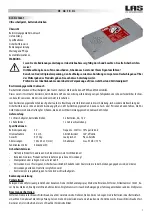
GSM/GPRS Module Series
M66 Hardware Design
M66_Hardware_Design Confidential / Released 71 / 80
7.2. Soldering
The squeegee should push the paste on the surface of the stencil that makes the paste fill the stencil
openings and penetrate to the PCB. The force on the squeegee should be adjusted so as to produce a
clean stencil surface on a single pass. To ensure the module soldering quality, the thickness of stencil at
the hole of the module pads should be
0.2 mm for M66.For more details, please refer to
document [12]
It is suggested that peak reflow temperature is from 235ºC to 245ºC (for SnAg3.0Cu0.5 alloy). Absolute
max reflow temperature is 260ºC. To avoid damage to the module when it was repeatedly heated, it is
suggested that the module should be mounted after the first panel has been reflowed. The following
picture is the actual diagram which we have operated.
Time(s)
50
100
150
200
250
300
50
100
150
200
250
160
℃
200
℃
217
0
70s~120s
40s~60s
Between 1
~
3
℃
/S
Preheat
Heating
Cooling
℃
s
Liquids
Temperature
Figure 48: Ramp-Soak-Spike Reflow Profile
7.3. Packaging
The modules are stored in a vacuum-sealed bag which is ESD protected. It should not be opened until the
devices are ready to be soldered onto the application.
Quectel
Confidential










































